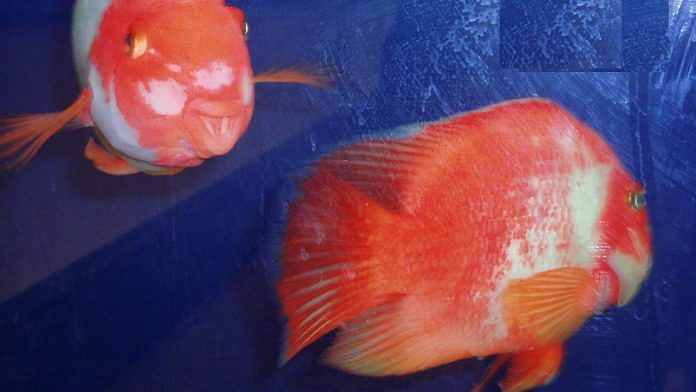New Delhi: Cichlid fish — which brood their young in their mouths — end up eating up to 40 per cent of their offspring, scientists at Central Michigan University have found.
Prior research has shown that cichlid fish brood their young in their mouths for up to two weeks after their eggs are fertilised.
There has also been some evidence suggesting that sometimes, the mothers eat their young before they have a chance to mature and leave. In this new effort, the researchers took a closer look at the fish to learn more about their reproductive habits.
In their lab, 80 females laid eggs that were fertilised by males. After fertilisation, the researchers observed how the brooding proceeded. As expected, the mothers kept their offspring in their mouths for up to two weeks. As they did so, the researchers noted that the mothers did not eat regular food.
They also found the mothers behaved in ways the researchers describe as stressed. The researchers dissected some of the mothers showing different levels of stress and found higher levels of stress chemicals in those fish who behaved in more stressed-out ways.
The researchers also found that on average, the mothers ate approximately 40 per cent of their offspring and that 93 per cent of them had eaten at least some of their young. They also found that those mothers who appeared to be more stressed tended to eat more of their young. Read more
Also Read: Chinese rocket debris shuts down Spain airspace & the mosquito behind Ethiopia’s malaria epidemic
Earliest known life on Earth discovered, reveals clues about life on Mars
Scientists have discovered evidence for the earliest known life on Earth in layered rocks in Western Australia.
The fossils, found by researchers at the Natural History Museum in London, are stromatolites – layered rocks that are formed by the excretions of photosynthetic microbes.
The oldest stromatolites that scientists agree were made by living organisms date back 3.43 billion years, but there are older specimens, too. In the Dresser Formation of Western Australia, stromatolites dating back 3.48 billion years have been found.
However, billions of years have wiped away traces of organic matter in these older stromatolites, raising questions about whether they were really formed by microbes or whether they might have been made by other geological processes.
The findings could have implications for the search for life on Mars. The stromatolites in the Dresser Formation are encrusted in iron oxide from the reaction of iron with oxygen in the atmosphere.
Mars’ surface is similarly oxidised — thus the rusty orange color — but its rocks could hold similar structures left behind by ancient Martian life. Read more
Also read: Huge Tonga volcanic eruption this year led to bloom of microscopic marine life, find scientists
Scientists spot a black hole gobbling up a star
Scientists have discovered an intermediate-mass black hole lurking undetected in a dwarf galaxy as it was gobbling up a star that strayed too close.
The shredding of the star, known as a “tidal disruption event” or TDE, produced a flare of radiation that briefly outshone the combined stellar light of the host dwarf galaxy.
The discovery, made by an international team led by scientists at the University of California, Santa Cruz, the Niels Bohr Institute at the University of Copenhagen, and Washington State University, could help scientists better understand the relationships between black holes and galaxies.
Supermassive black holes are found at the centres of all massive galaxies, including our own Milky Way. Astronomers conjecture that these massive beasts, with millions or billions of times the mass of the sun, could have grown from smaller “intermediate-mass” black holes with thousands to hundreds of thousands of solar masses.
One theory for how such massive black holes were assembled is that the early universe was rampant with small dwarf galaxies with intermediate-mass black holes. Over time, these dwarf galaxies would have merged or been gobbled up by more massive galaxies, their cores combining each time to build up the mass in the center of the growing galaxy. This merger process would eventually create the supermassive black holes seen today. Read more
Artificial photosynthesis can help produce more fuel
Scientists from the University of Chicago have created an innovative new system for artificial photosynthesis that’s more productive than previous artificial systems.
Unlike regular photosynthesis, which produces carbohydrates from carbon dioxide and water, artificial photosynthesis could produce ethanol, methane, or other fuels.
Researchers looking to create alternatives to fossil fuels have to re-engineer the process of photosynthesis to create energy-dense fuels, such as ethanol or methane.
In nature, photosynthesis is performed by several very complex assemblies of proteins and pigments to create carbohydrates, which fuel life.
They take in water and carbon dioxide, break the molecules apart, and rearrange the atoms to make carbohydrates — a long string of hydrogen-oxygen-carbon compounds.
Scientists, however, reworked the reactions to instead produce CH4 or methane. The research could be applied widely to other chemical reactions to create raw materials for pharmaceutical drugs and nylons, among others. Read more
(Edited by Uttara Ramaswamy)
Also Read: Scientists surprised by their discovery of heaviest element Barium in atmosphere of 2 exoplanets






